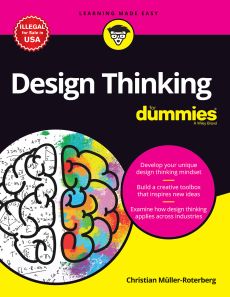Design Thinking For Dummies
ISBN: 9788126520688
For more information write to us at: acadmktg@wiley.com

Description
Design thinking is not just the property of graphic designers. This approach to creating solutions by thinking from the customer perspective can lead to new and innovative ideas that old methods could not approach. Design Thinking For Dummies provides a jump-start to get you and your organization on the path to new creativity. Written by a design thinking thought leader, this book helps you through the design thinking cycle and shows how it can help any industry.
Introduction
About This Book
Conventions Used in This Book
Foolish Assumptions
What You Don't Have to Read
How This Book Is Organized
Part : 1 Getting Started with Design Thinking
Part : 2 The Problem Phases
Part : 3 The Solution Phases
Part : 4 The Part of Tens
Icons Used in This Book
Beyond the Book
Where to Go from Here
Part 1: Getting Started with Design Thinking
Chapter 1: Everything You Need to Know About Design Thinking
- This Is Design Thinking
- More than just design
- More than just a workshop
- More than just brainstorming
- More than just methods
- Seeing What Design Thinking Can Do
- Developing new products
- Creating new services
- Designing new business models
- Designing social and organizational innovations
- Establishing a culture of innovation
- Understanding the Basics of Design Thinking
- Following and communicating the principles
- Getting an overview of the whole process
- Going through the process in detail
- Start Design Thinking Right Away
- Assembling the team
- Defining team roles and communication practices
- Planning the project work
- Furnishing the work environment
- Asking for support
Chapter 2: Understanding the Principles of Design Thinking
- Focusing on People Early On
- More than Traditional Market Research
- Finding the Lead User
- Actively Involving the Lead User
- Developing Empathy
- Illustrating Ideas
- Failing in Order to Learn
- Ensuring Diversity on the Team
- Offering Team-Oriented and Creative Workspaces
- Making the Process Flexible Yet Focused
Chapter 3: Creating Ideal Conditions
- Ensuring a Positive Attitude
- Creating the vision for the project
- Communicating the vision
- Encouraging the Willingness to Change
- Arousing Curiosity
- Presenting the task as a challenge
- Presenting the task as a reward
- Presenting the task in a comprehensible fashion
- Training curiosity
- Asking For (and Receiving) Support from the Top
- Asking For (and Receiving) Creative Freedom
- Enabling Fast Decisions in the Design Thinking Process
- Setting up the steering committee
- Clarifying responsibilities
- Preparing the decision in an efficient manner
- Conducting the decision-making process in an efficient manner
- Following up on decisions
- Tolerating Mistakes During Design Thinking
- Defining mistakes
- Looking at mistakes in a differentiated way
- Find the Competencies You Need for the Task at Hand
- Determining the target competencies
- Taking stock of the actual competencies
- Comparing the target and actual competencies and coming up with the next steps
- Checking the competencies on an ongoing basis
- Ensuring that the work is appreciated
Chapter 4: Planning a Design Thinking Project
- Defining the Project Goals
- Compiling goals and determining their order
- Clearly formulating goals
- Communicating goals
- Planning Work Packages
- Planning work packages for incremental progress at just the right time
- Formulating and determining the work package order from the user's perspective
- Using a task board
- Correctly Planning for the Sequence
- Estimating the required time
- Creating a bar graph for a better overview
- Correctly Planning for Your Resources
- Correctly Planning for the Project Budget
Chapter 5: Supporting Teamwork in the Project
- Assembling the Team
- Relying on variety in team makeup
- Defining roles on the team
- Creating a matrix of responsibility
- Applying the principle of self-organization
- Clarifying Communication within the Team
- Determining the project reporting format
- Communicating is more important than documenting
- Setting up communication rules
- Arranging Workshops
- Preparing a workshop
- Holding workshops correctly
- Providing equipment and materials
- Designing Common Spaces
- The right rooms promote communication and creativity
- A flexible environment promotes flexible work
Part 2: The Problem Phases
Chapter 6: Understanding the Task
- Finding the Right Search Area
- Searching in the market segment
- Searching in the area of technology
- Searching in your own area of competence
- A Well-Defined Task Is a Task Half-Solved
- Clarifying what the task is and how it manifests itself
- Clarifying who has the problem or wish
- Clarifying where and when the problem or wish occurs
- Clarifying why the problem or wish occurs
- Identifying Knowledge Gaps
- Systematically Closing Knowledge Gaps
- Estimating Influences on the Task
- Evaluating environmental influences
- Identifying stakeholder influences
- Reformulating the Task
Chapter 7: Putting Yourself in the Roles of Others
- Recognizing Empathy as a Key to Success
- Proceeding with Empathy
- Create openness
- Discount your own ideas/Tamp down your own biases
- Share results
- Proceed methodically
- Collecting Information
- Evaluating Information
- Characterizing a customer using the Persona method
- Understanding the situation with the help of an empathy map
- Exploring the process with the customer journey
- Describing the phases of the customer journey
- Discovering the problems (and improvements) in the customer journey
Chapter 8: Observing People in Action
- Putting Observations to Proper Use
- Thoroughly Preparing Your Observations
- Determine who should be observed
- Determine what you should observe, whom you should observe

